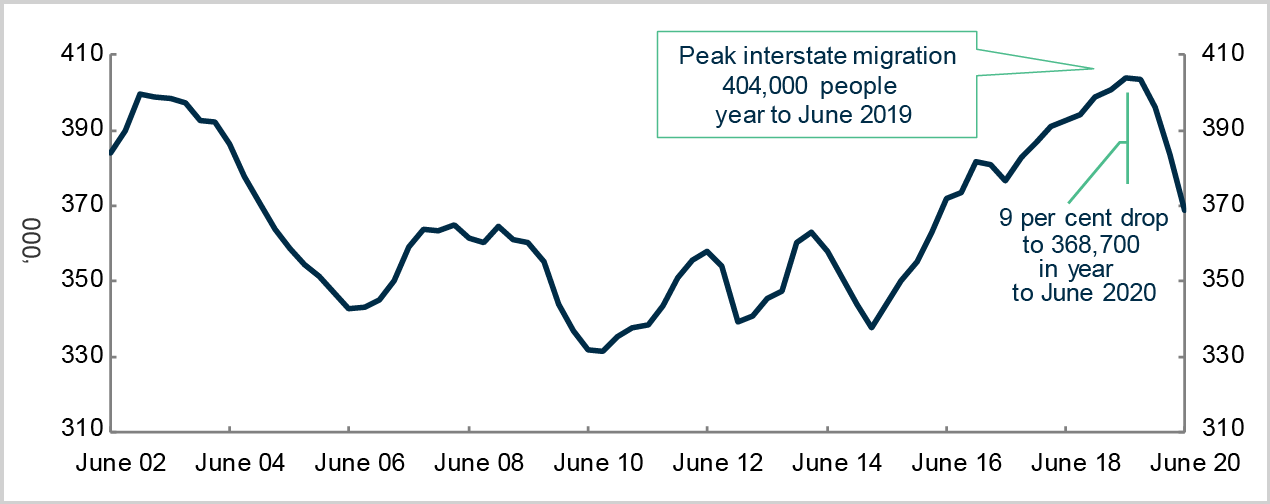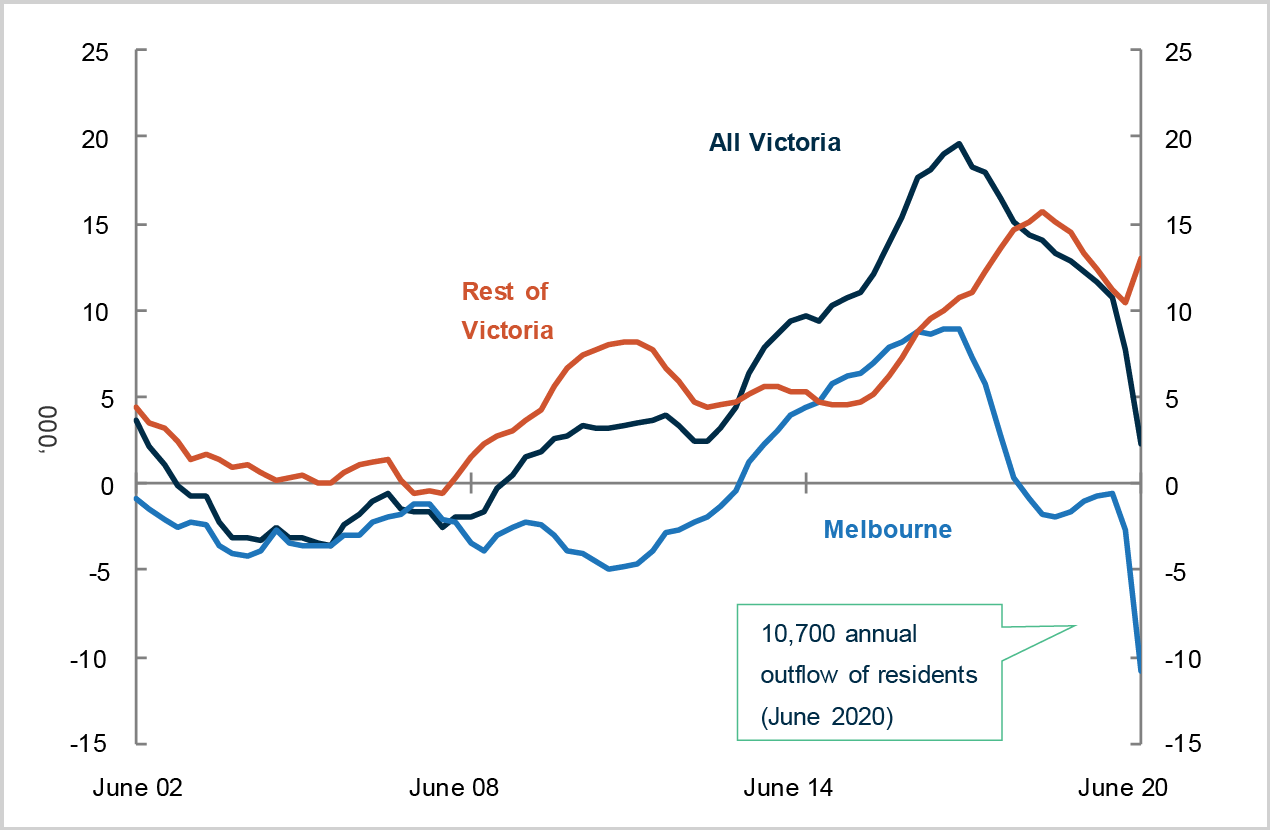This page has now been archived Key data releases
Centre for Population analysis of the Regional population data from the Australian Bureau of Statistics (ABS)
Reference period: -
COVID‑19 has reduced the level of internal migration around Australia. Provisional data shows the number of people moving interstate is down 9 per cent in the 12 months to June 2020.
COVID‑19 is also affecting the locations people are choosing to move to, with lower net migration to the state and territory capitals. Net internal migration in areas outside of the capital cities rose to 30,100.
Effects from the second wave of COVID‑19 cases in Melbourne are starting to show in provisional data, with a net loss of 10,700 residents from the city in the 12 months to June 2020, compared with a loss of 1,000 residents in the year to June 2019. In the June 2020 quarter, the most common destination for those leaving Melbourne was outside the capital city in Victoria (11,700 people).
PRIME is a new release from the ABS, funded by the Centre for Population, Treasury. The release provides quarterly regional internal migration estimates to June 2020, showing the early impact of COVID‑19. The data in this release is provisional and may be revised in future ABS releases of internal migration data. The next release of PRIME is expected to be in early February 2021.
Timing of COVID‑19 impacts in this data
Interstate migration estimates are based on Medicare change of address data. When calculating migration estimates based on Medicare data, the ABS assumes a three month lag between the actual change of address and the update of the Medicare address. This assumption may lead to movements that occurred in the September quarter (1 July to 30 September) being allocated to the June quarter. This may help explain the large net migration from Melbourne. This data should not be used to pinpoint the onset of time specific events like the imposition of Stage 4 restriction in Victoria, or hard border closures across the states and territories.
COVID‑19 restrictions and the economic impact have driven down interstate migration
In the 12 months to June 2020, there were 35,300 fewer interstate moves compared to June 2019, a drop of 9 per cent. This follows the highest annual level of interstate migration in 20 years in the year to 2019 when 404,000 people relocated interstate.

This observation of fewer interstate movements is in line with expectations and is driven by restrictions on movement due to COVID‑19 and the resulting economic uncertainty. This matches declines in interstate movements observed during past economic downturns in Australia and internationally. Future PRIME data releases will provide further insights into the impact of COVID‑19 on internal migration, including hard border closures and the Victorian lockdown which occurred in the September quarter.
COVID‑19 is also changing where people move to
In the year to June 2020, PRIME data shows there has been a change in the movement of people between state and territory capital cities and regions outside the capitals. Regions outside the capital cities had a net gain of 30,100 people, compared with 23,800 in the year to June 2019.
The net gain of people in regions outside capital cities was driven by a decrease in the number of people moving from regions to the capitals. Around 198,000 residents moved from regions to the capital cities in the 12 months to June 2020, 20,200 fewer than the 218,100 that moved in the year to June 2019.
Changes to internal migration by age group
Compared to the June 2019 quarter, the largest changes to internal migration in the June 2020 quarter have occurred in the 25 to 44 year age group. In net terms, at the state level 4,500 fewer people in the 25 to 44 year age group migrated in the June 2020 quarter compared to the June 2019 quarter, driven primarily by a reduction in net interstate migration for Victoria. The same age group saw 2,600 more people in net terms move from capital cities to areas outside capital cities in the June 2020 quarter compared to the June 2019 quarter. This change was driven by a decrease in the number of moves from areas outside capital cities to the capital cities, with the level of migration from capital cities to areas outside the capital cities remaining relatively stable between the June 2019 and June 2020 quarters.
Changes to internal migration by state and territory
While there was an overall shift in the number of people moving between, to and from capital cities in Australia, patterns of internal migration varied within states and territories.
In the year to June 2020, Melbourne had a net outflow of 10,700 residents, which is 10 times larger than the outflow observed in the year to June 2019 (−1,000). In the June 2020 quarter, the most common destination for people leaving Melbourne was outside the capital city in Victoria, which had a net inflow of 13,000 people in the year to June 2020.
This increased net outflow of people from Melbourne predates the second lockdown that started in Melbourne in early July. However, due to the assumed three month lag in address change data used to prepare PRIME, some impact from the second lockdown may be present in the June quarter figures.

Queensland had the largest net gain of people compared to all other states and territories in Australia for the year ending June 2020, with 23,500 people arriving in the state in net terms. Within Queensland, Brisbane had a net inflow of 13,500 people while the areas outside the capital city had a net inflow of 11,800 people.
Historically, Queensland has been a strong net gainer of internal migrants, particularly people from New South Wales and Victoria. Arrivals of people from Victoria to Queensland in the June 2020 quarter remained consistent with levels in June 2019 (6,100 people compared with 6,400 people respectively).
New South Wales saw the number of people leaving the state decline in the year to June 2020 (−20,900 people) compared to the year to June 2019 (−22,100 people). This reflects the expected overall decline in the level of interstate migration, driven by COVID‑19 restrictions and economic uncertainty.
Western Australia had a net outflow of 2,400 people in the year to June 2020, 4,000 people fewer compared to the net outflow of 6,500 people in the year to June 2019. Perth recently recorded a net inflow of people (1,000 people) for the first time since 2014. The net outflow experienced by WA since 2014 was partly driven by the end of the mining construction boom.
The Northern Territory, which has had outflows of residents in recent years, saw the net outflow decline, from 4,400 in the year to June 2019 to 2,700 in the year to June 2020.
South Australia has recorded a smaller net outflow of residents in the year to June 2020 (−2,200 people) compared to the year to June 2019 (−4,000 people).
Tasmania recorded a smaller net inflow of residents in the year to June 2020 (1,200 people) compared to the year to June 2019 (2,000 people).
The ACT saw a larger net outflow of residents in the year to June 2020 (−700 people) compared to the year to June 2019 (−200 people).
New detailed data, commissioned by the Centre for Population, Treasury
This is the first time that PRIME data has been released by the ABS. This data provides quarterly estimates of interstate migration and internal migration between capital cities and areas outside the capital cities. These estimates are based on Medicare change of address data (provided by Services Australia). Prior to this release, sub‑state data was only available annually.
The quarterly release of PRIME data has been funded by the Centre for Population and provides timely and detailed data on internal migration patterns. This new data provides insight into the immediate impact of COVID‑19 restrictions. Future releases of PRIME data will provide further insights into the impact of COVID‑19 on internal migration, in particular the impact of the imposition of Stage 4 restrictions in Melbourne in July 2020.